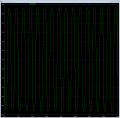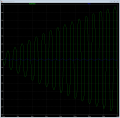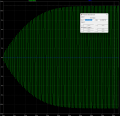Hello!
We have a spice exercise about the differential amplifier. In the following examples, the circuit is directly given to us without the Q1 bias resistor. By doing a DC parameter sweep, I found out that the Q1 bias resistor must be equal to the Q2 1.8MΩ in order to work the amplifier in Common Mode, which makes sense in my opinion. The V(c1) = Vc(2) = 7.56V is also ideal because it's exactly Vcc/2 (Vcc = 15V) which will give the best possible swing in the output.


Now, using a 1kHz Vpp=0.1V input, using an Ideal NPN transistor, the result is the following:


Using an Non Ideal NPN (BC238) transistor, the result is the following:


Clearly, the system is unstable!
Why is that? Have I used the wrong model? I just found it on the internet. Even for a non ideal transistor, this is weird, I've never seen this again.
BC238 Model (Source https://www.elelab.itu.edu.tr/belgeler/pspice/bc238.txt):
Thanks!
We have a spice exercise about the differential amplifier. In the following examples, the circuit is directly given to us without the Q1 bias resistor. By doing a DC parameter sweep, I found out that the Q1 bias resistor must be equal to the Q2 1.8MΩ in order to work the amplifier in Common Mode, which makes sense in my opinion. The V(c1) = Vc(2) = 7.56V is also ideal because it's exactly Vcc/2 (Vcc = 15V) which will give the best possible swing in the output.


Now, using a 1kHz Vpp=0.1V input, using an Ideal NPN transistor, the result is the following:


Using an Non Ideal NPN (BC238) transistor, the result is the following:


Clearly, the system is unstable!
Why is that? Have I used the wrong model? I just found it on the internet. Even for a non ideal transistor, this is weird, I've never seen this again.
BC238 Model (Source https://www.elelab.itu.edu.tr/belgeler/pspice/bc238.txt):
In the attachments, you will also find three .rar files with the LTspice files for each of these simulations (DC Sweep, Transient BC238, and Transient NPN Ideal) for the last 2, I have named them Distortion and No Distortion..MODEL BC238 NPN (
+IS =1.8E-14 ISE=5.0E-14 NF =.9955 NE =1.46 BF =400
+BR =35.5 IKF=.14 IKR=.03 ISC=1.72E-13 NC =1.27 NR =1.005 RB =.56 RE =.6
+RC =.25 VAF=80 VAR=12.5 CJE=13E-12 TF =.64E-9 CJC=4E-12 TR =50.72E-9
+VJC=.54 MJC=.33 )
Thanks!
Attachments
-
15.1 KB Views: 1
-
89.3 KB Views: 1
-
80.5 KB Views: 1











